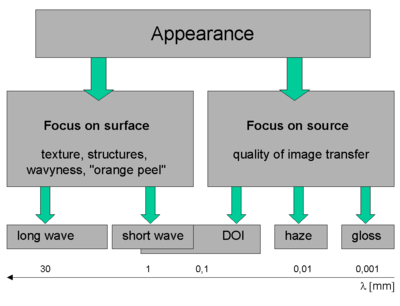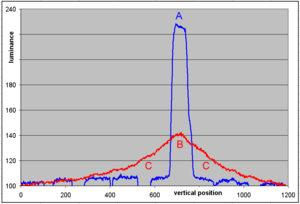
The reflectance of the surface of a material is its effectiveness in reflecting radiant energy. It is the fraction of incident electromagnetic power that is reflected at the boundary. Reflectance is a component of the response of the electronic structure of the material to the electromagnetic field of light, and is in general a function of the frequency, or wavelength, of the light, its polarization, and the angle of incidence. The dependence of reflectance on the wavelength is called a reflectance spectrum or spectral reflectance curve.

In colorimetry, metamerism is a perceived matching of colors with different (nonmatching) spectral power distributions. Colors that match this way are called metamers.
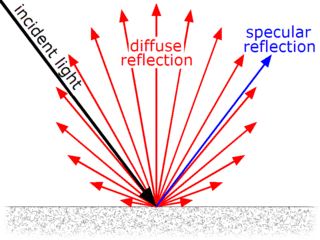
Diffuse reflection is the reflection of light or other waves or particles from a surface such that a ray incident on the surface is scattered at many angles rather than at just one angle as in the case of specular reflection. An ideal diffuse reflecting surface is said to exhibit Lambertian reflection, meaning that there is equal luminance when viewed from all directions lying in the half-space adjacent to the surface.

Specular reflection, or regular reflection, is the mirror-like reflection of waves, such as light, from a surface.
Bidirectional texture function (BTF) is a 6-dimensional function depending on planar texture coordinates (x,y) as well as on view and illumination spherical angles. In practice this function is obtained as a set of several thousand color images of material sample taken during different camera and light positions.
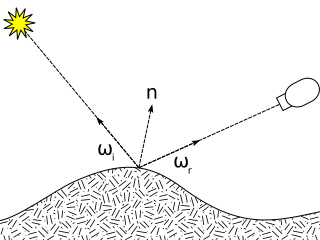
The bidirectional reflectance distribution function is a function of four real variables that defines how light is reflected at an opaque surface. It is employed in the optics of real-world light, in computer graphics algorithms, and in computer vision algorithms. The function takes an incoming light direction, , and outgoing direction, , and returns the ratio of reflected radiance exiting along to the irradiance incident on the surface from direction . Each direction is itself parameterized by azimuth angle and zenith angle , therefore the BRDF as a whole is a function of 4 variables. The BRDF has units sr−1, with steradians (sr) being a unit of solid angle.
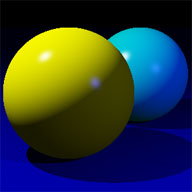
A specular highlight is the bright spot of light that appears on shiny objects when illuminated. Specular highlights are important in 3D computer graphics, as they provide a strong visual cue for the shape of an object and its location with respect to light sources in the scene.

Path tracing is a computer graphics Monte Carlo method of rendering images of three-dimensional scenes such that the global illumination is faithful to reality. Fundamentally, the algorithm is integrating over all the illuminance arriving to a single point on the surface of an object. This illuminance is then reduced by a surface reflectance function (BRDF) to determine how much of it will go towards the viewpoint camera. This integration procedure is repeated for every pixel in the output image. When combined with physically accurate models of surfaces, accurate models of real light sources, and optically correct cameras, path tracing can produce still images that are indistinguishable from photographs.
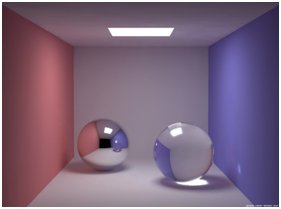
Gloss is an optical property which indicates how well a surface reflects light in a specular (mirror-like) direction. It is one of the important parameters that are used to describe the visual appearance of an object. Other categories of visual appearance related to the perception of regular or diffuse reflection and transmission of light have been organized under the concept of cesia in an order system with three variables, including gloss among the involved aspects. The factors that affect gloss are the refractive index of the material, the angle of incident light and the surface topography.
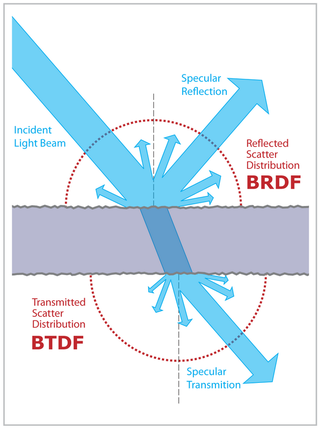
The definition of the BSDF is not well standardized. The term was probably introduced in 1980 by Bartell, Dereniak, and Wolfe. Most often it is used to name the general mathematical function which describes the way in which the light is scattered by a surface. However, in practice, this phenomenon is usually split into the reflected and transmitted components, which are then treated separately as BRDF and BTDF.

Glare is difficulty of seeing in the presence of bright light such as direct or reflected sunlight or artificial light such as car headlamps at night. Because of this, some cars include mirrors with automatic anti-glare functions and in buildings, blinds or louvers are often used to protect occupants. Glare is caused by a significant ratio of luminance between the task and the glare source. Factors such as the angle between the task and the glare source and eye adaptation have significant impacts on the experience of glare.

Sheen is a measure of the reflected light (glossiness) from a paint finish. Glossy and flat are typical extreme levels of glossiness of a finish. Gloss paint is shiny and reflects most light in the specular (mirror-like) direction, while on flat paints most of the light diffuses in a range of angles. The gloss level of paint can also affect its apparent colour.
A transparency meter, also called a clarity meter, is an instrument used to measure the transparency of an object. Transparency refers to the optical distinctness with which an object can be seen when viewed through plastic film/sheet, glass, etc. In the manufacture of sheeting/film, or glass the quantitative assessment of transparency is just as important as that of haze.
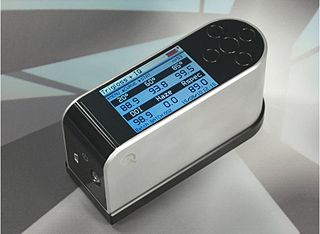
A glossmeter is an instrument which is used to measure specular reflection gloss of a surface. Gloss is determined by projecting a beam of light at a fixed intensity and angle onto a surface and measuring the amount of reflected light at an equal but opposite angle.

Distinctness of image (DOI) is a quantification of the deviation of the direction of light propagation from the regular direction by scattering during transmission or reflection. DOI is sensitive to even subtle scattering effects; the more light is being scattered out of the regular direction the more the initially sharp image is blurred. In polluted air it is the sum of all particles of various dimensions that induces haze.

Photometric stereo is a technique in computer vision for estimating the surface normals of objects by observing that object under different lighting conditions (photometry). It is based on the fact that the amount of light reflected by a surface is dependent on the orientation of the surface in relation to the light source and the observer. By measuring the amount of light reflected into a camera, the space of possible surface orientations is limited. Given enough light sources from different angles, the surface orientation may be constrained to a single orientation or even overconstrained.
The study of image formation encompasses the radiometric and geometric processes by which 2D images of 3D objects are formed. In the case of digital images, the image formation process also includes analog to digital conversion and sampling.
There are two different types of haze that can occur in materials:

Physically based rendering (PBR) is a computer graphics approach that seeks to render images in a way that models the lights and surfaces with optics in the real world. It is often referred to as "Physically Based Lighting" or "Physically Based Shading". Many PBR pipelines aim to achieve photorealism. Feasible and quick approximations of the bidirectional reflectance distribution function and rendering equation are of mathematical importance in this field. Photogrammetry may be used to help discover and encode accurate optical properties of materials. PBR principles may be implemented in real-time applications using Shaders or offline applications using Ray tracing (graphics) or Path tracing.
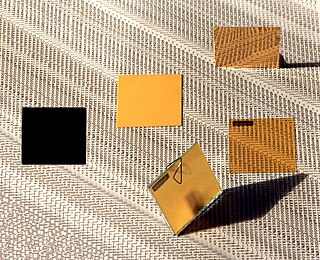
Cesia is the name given to visual appearances related to the perception of different spatial distributions of light. Light radiation that is not absorbed by an object can be reflected or transmitted either diffusely or regularly. These interactions of light with matter are perceived with a greater or lesser degree of gloss, more or less transparent, translucent or opaque, at different levels of darkness.
